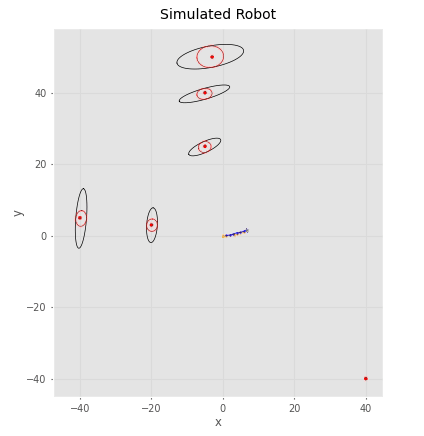Feature-based SLAM using an EKF
Hands-On Localization
Collaborator(s):
This project explores the implementation of Feature-Based SLAM (Simultaneous Localization and Mapping) using an Extended Kalman Filter (EKF) to localize a differential drive mobile robot in a simulated environment. SLAM is a core challenge in robotics, enabling a robot to construct a map of its surroundings while simultaneously estimating its position within that map.
In this implementation, point features in the environment are used to estimate both the robot’s state and the environment’s map. The project employs input displacement and constant velocity motion models to address the SLAM problem. Observed features are stored in 2D Cartesian space, while Iterative Closest Neighbors Nearest (ICNN) is applied for data association, ensuring that observed features are correctly matched with previously mapped landmarks.
Methodology
- Extended Kalman Filter (EKF): The EKF is used as a recursive estimator to predict the robot’s state and update the estimate based on observed environmental features. The filter’s ability to handle noisy sensor data makes it an essential part of the SLAM process.
-
Motion Models: Both input displacement and constant velocity motion models were used to simulate the robot’s movement. These models help estimate the robot’s state as it navigates through the environment.
-
Feature Observation: Environmental features were observed in polar space but stored in Cartesian space. This method provided flexibility in handling different observation models, allowing the system to adapt to changing environments.
- Data Association with ICNN: The ICNN algorithm was implemented for data association, ensuring that observed features are correctly matched with previously identified landmarks. This association is critical for improving the accuracy of the SLAM system and avoiding incorrect mapping of features.
Results
The FEKF SLAM algorithm was tested in simulation to assess its robustness in solving the SLAM problem for a differential drive robot. The results showed that the algorithm efficiently handled prediction and updates while incorporating new features to refine the localization over time.
The integration of the EKF with feature-based SLAM enabled the robot to map its environment more accurately, even without prior knowledge of the surroundings. The system consistently improved localization accuracy with each iteration, providing reliable performance in mapping unknown environments.
Demonstration
Below are visual demonstrations of the Feature-based SLAM system in action. The left image shows the robot’s localization results in simulation, while the right image highlights the system performing feature-based SLAM with the EKF algorithm.

